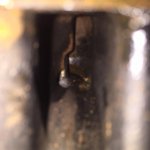Hi,
I have an Indmar Assualt 5.7 / 350 TBI from 2002. Engine very similar to a Mercruiser, hopefully it is ok to post in this part of the forum, didn't find Indmar.
Background:
Last year my exhaust valve spring on #7 cylinder broke, it just snapped. I didn't run the engine and got towed to dock. I replaced the spring and the valve stem seal (which was damaged). Luckily everything seemed fine after that. Compression was good (190 PSI) and engine ran great.
This season I have been experiencing some intermittent hard starts (not very, but needed to give a bit of throttle) combined with some blue smoke at start up, that quickly disappeared.
Late in the season once or twice I heard what I think was sticking valve(s) that faded and disappeared once engine was warm.
I did a compression test yesterday and found that all cylinders show 180-200 PSI except #7 that reads 100 PSI. I don't have the equipment to perform a leak-down test, but blew air into the cylinder (at TDC) with my compressor. I could hear the air leaking out the exhaust.
As I had already winterized my engine and the ambient temperature is right around freezing now I performed these tests on a (very) cold engine.
After pulling the exhaust manifold I can see that the #7 exhaust port is wet or rather oily. The valve stem is covered in what I believe is oil, but even the walls look wet. The other ones all look about the same, not pretty, but dry carbon a some rust spots that I guess is due to condensation in the exhaust.
Since I had to pull my heads a few years back at that time I bought a fel pro 17232 gasket set and included in that I got 16 valve stem seals in a bag stamped 70817B.
They don't look the same as the ones originally on there. These have a steel spring instead of a steel "jacket" around them. But from what I understand they should be the correct replacement. This is what I put on #7 exhaust valve anyways.
So questions are:
Why is the #7 exhaust wet with oil? Leaking valve seal?
Can this explain the low compression?
Will it then get better if I start the engine and run a hot test, thinking that maybe the excessive oil will be burned from the engine running and then the valve might seal better?
Is this the wrong seal or did I mess up installation? Or does it rather indicate a damaged valve guide?
Thanks for any help!
I am attaching pictures of the oily (I smudged the oil a bit with my finger before snapping the pic) and "normal" exhaust ports.


I have an Indmar Assualt 5.7 / 350 TBI from 2002. Engine very similar to a Mercruiser, hopefully it is ok to post in this part of the forum, didn't find Indmar.
Background:
Last year my exhaust valve spring on #7 cylinder broke, it just snapped. I didn't run the engine and got towed to dock. I replaced the spring and the valve stem seal (which was damaged). Luckily everything seemed fine after that. Compression was good (190 PSI) and engine ran great.
This season I have been experiencing some intermittent hard starts (not very, but needed to give a bit of throttle) combined with some blue smoke at start up, that quickly disappeared.
Late in the season once or twice I heard what I think was sticking valve(s) that faded and disappeared once engine was warm.
I did a compression test yesterday and found that all cylinders show 180-200 PSI except #7 that reads 100 PSI. I don't have the equipment to perform a leak-down test, but blew air into the cylinder (at TDC) with my compressor. I could hear the air leaking out the exhaust.
As I had already winterized my engine and the ambient temperature is right around freezing now I performed these tests on a (very) cold engine.
After pulling the exhaust manifold I can see that the #7 exhaust port is wet or rather oily. The valve stem is covered in what I believe is oil, but even the walls look wet. The other ones all look about the same, not pretty, but dry carbon a some rust spots that I guess is due to condensation in the exhaust.
Since I had to pull my heads a few years back at that time I bought a fel pro 17232 gasket set and included in that I got 16 valve stem seals in a bag stamped 70817B.
They don't look the same as the ones originally on there. These have a steel spring instead of a steel "jacket" around them. But from what I understand they should be the correct replacement. This is what I put on #7 exhaust valve anyways.
So questions are:
Why is the #7 exhaust wet with oil? Leaking valve seal?
Can this explain the low compression?
Will it then get better if I start the engine and run a hot test, thinking that maybe the excessive oil will be burned from the engine running and then the valve might seal better?
Is this the wrong seal or did I mess up installation? Or does it rather indicate a damaged valve guide?
Thanks for any help!
I am attaching pictures of the oily (I smudged the oil a bit with my finger before snapping the pic) and "normal" exhaust ports.


























